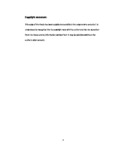ACUTE-LPS MEDIATED MYELIN INJURY
| dc.contributor.supervisor | Fern, Robert | |
| dc.contributor.author | Stone, Gideon | |
| dc.contributor.other | Faculty of Health | en_US |
| dc.date.accessioned | 2022-05-19T16:00:06Z | |
| dc.date.available | 2022-05-19T16:00:06Z | |
| dc.date.issued | 2022 | |
| dc.identifier | 10559606 | en_US |
| dc.identifier.uri | http://hdl.handle.net/10026.1/19238 | |
| dc.description.abstract |
Background: Multiple Sclerosis is a notorious neurological disease strongly linked to auto-immune pathogenesis and involvement of inflammatory cytokines, resulting in CNS white matter injury. To date, there is no known cure and a limited number of successful treatments, with the exact pathogenic mechanisms of the disease being unknown. Due to this there is a high demand for the development of effective treatments. With the primary use of anti-inflammatory treatments, the symptoms can be significantly reduced, and the occurrence of relapses and exacerbations can be managed. The use of animal models such as EAE and cuprizone has helped drastically with the understanding of the disease and have been used to formulate the current treatments available to great success. This project will aim to speed up this process by laying the groundwork for a novel in-vitro model of white matter disruption resulting in speedy drug testing and reduced live animal experimentation. Hypothesis: Acute LPS exposure to ex-vivo mice optic nerves will cause myelin disruption to both myelinated axons and oligodendrocyte cell bodies. Methods: Optic nerves from both CD1 mice and transgenic PLP-GFP mice were isolated and stained using Fluoromyelin red, while being maintained in aCSF solution at 37oC. This was followed by acute lipopolysaccharide (LPS) exposure at varying concentrations for 120 minutes. After the insult period confocal microscopy was used to capture images showing myelinated axons of the optic nerves, as well as the oligodendrocyte cell bodies in the PLP positive mice which express the PLP promoter 6 that drives the expression of a green fluorescent protein (PLP-GFP). Following the microscopy, the program image J was used to measure the fluorescence of the white matter of the varying structures and allow for statistical analyses of the structural integrity of the optic nerves. Results : Five mice were used per experiment. 1 μg-mol LPS showed significant myelin disruption (p < 0.04) in comparison to insignificant results gathered from 0.1 μg-mol LPS application (p < 0.666), both using CD1 mice. PLP-GFP negative mice also showed significant myelin injury following LPS insult, solidifying the results found in the CD1 mice (p < 0.01). Damage was not restricted to the myelinated axons but also affected oligodendrocyte cell body structure. Significant damage was shown with the use of PLP-GFP positive stacked images showing decreased fluorescence (p < 0.027), decreased cell area (p < 0.007) and increased cell process damage (p < 0.001), with no change to oligodendrocyte cell count (p < 0.77). Application of Methylprednisolone (MP) at a concentration of 10 μM limited inflammation in CD1 optic nerves (p < 0.608). Conclusion : Acute LPS exposure on CD1 and PLP-GFP optic nerves elicit an inflammatory response and subsequent myelin injury through the activation of the MyD88 pathway. This pathway is strongly implicated in the pathogenesis of MS through the upregulation of TLRs and produced cytokines. Our findings suggest that LPS can be used as a new in-vivo model of MS, allowing for rapid therapy testing and reduced animal experimentation. | en_US |
| dc.language.iso | en | |
| dc.publisher | University of Plymouth | |
| dc.rights | Attribution 3.0 United States | * |
| dc.rights.uri | http://creativecommons.org/licenses/by/3.0/us/ | * |
| dc.subject.classification | ResM | en_US |
| dc.title | ACUTE-LPS MEDIATED MYELIN INJURY | en_US |
| dc.type | Thesis | |
| plymouth.version | publishable | en_US |
| dc.identifier.doi | http://dx.doi.org/10.24382/1207 | |
| dc.rights.embargoperiod | No embargo | en_US |
| dc.type.qualification | Masters | en_US |
| rioxxterms.version | NA |
Files in this item
This item appears in the following Collection(s)
-
01 Research Theses Main Collection
Research Theses Main



